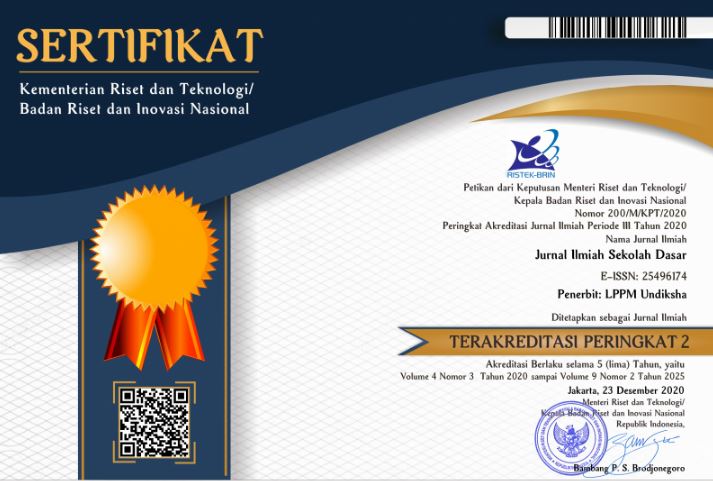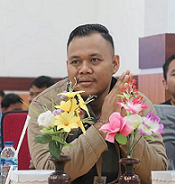Innovation of Differentiated Flipsains Integrated with STEAM and Tri-N in Increasing Creativity of Elementary School Students
DOI:
https://doi.org/10.23887/jisd.v8i2.69931Keywords:
Flipsains, Differentiated, STEAM, Tri N, CreativityAbstract
Creativity is one of the skills that a person must have in order to survive in this era of uncertainty. Creativity needs to be developed from an early age, including in elementary school learning. This research aims to develop science flipbook media (flipsains) based on differentiated learning integrated with STEAM and Tri-N approaches in increasing elementary school students' creativity. This research uses a development research method with ADDIE stages: analysis, design, development, implementation, and evaluation. The subjects studied in this research were fourth grade elementary school students, totalling 17 students in the limited trial and 56 students in extensive trial. Data collection techniques in this research were carried out using observation, interviews and questionnaires. The analysis technique for this research was carried out using qualitative and quantitative descriptive methods. The results of this research show that flipsains media was produced with characteristics based on differentiated learning which was designed with an initial assessment, equipped with various kinds of videos and various projects. Flipsains was also developed according to elements of the STEAM approach and the Tri-N Method. The validation results show that the flipsains developed is said to be valid with validation results of 90.2% with very feasible criteria. The developed flipsains has also proven to be effective in increasing elementary school students' creativity as evidenced by the increase in observation scores of students' creativity skills in limited trials and extensive trials.
References
Achilleos, A. P., Mettouris, C., Yeratziotis, A., Papadopoulos, G. A., Pllana, S., Huber, F., Jäger, B., Leitner, P., Ocsovszky, Z., & Dinnyés, A. (2019). SciChallenge: A Social Media Aware Platform for Contest-Based STEM Education and Motivation of Young Students. IEEE Transactions on Learning Technologies, 12(1), 98–111. https://doi.org/10.1109/TLT.2018.2810879. DOI: https://doi.org/10.1109/TLT.2018.2810879
Afandi, M., Wahyuningsih, S., Yustiana, S., Kusumadewi, R. F., & Rachmadtullah, R. (2023). Correlation of work discipline and pedagogical competence to teaching performance in elementary teacher. International Journal of Instruction, 16(4), 189–208. https://doi.org/10.29333/iji.2023.16412a. DOI: https://doi.org/10.29333/iji.2023.16412a
Ahmad, D. N., Astriani, M. M., Alfahnum, M., & Setyowati, L. (2021). Increasing Creative Thinking of Students by Learning Organization with STEAM Education. Jurnal Pendidikan IPA Indonesia, 10(1), 103–110. https://doi.org/10.15294/jpii.v10i1.27146. DOI: https://doi.org/10.15294/jpii.v10i1.27146
Al-Shehri, M. S. (2020). Effect of Differentiated Instruction on the Achievement and Development of Critical Thinking Skills among Sixth Grade Science Students. International Journal of Learning, Teaching and Educational Research, 19(10), 77–99. https://doi.org/10.26803/ijlter.19.10.5. DOI: https://doi.org/10.26803/ijlter.19.10.5
Aladwan, S. Q. A., Alfayez, M. Q. E., & Shaheen, H. R. A. (2023). The level of conceptual and procedural knowledge in mathematics and its relationship to creative thinking among gifted students. International Journal of Instruction, 16(4), 121–134. https://doi.org/10.29333/iji.2023.1648a. DOI: https://doi.org/10.29333/iji.2023.1648a
Ardilansari., N., M., H., Najamudin, & Nagy, E. K. (2023). The Right Method for Developing Elementary School Student’s Creative Thinking Skills. Jurnal Ilmiah Sekolah Dasar, 7(3). https://ejournal.undiksha.ac.id/index.php. DOI: https://doi.org/10.23887/jisd.v7i3.58273
Averina, L. S., & Mayarni. (2022). STEM-Based Everyone is a Teacher Here Strategy on Metacognitive Abilities. Jurnal Ilmiah Sekolah Dasar, 6(3), 509–515. https://doi.org/10.23887/jisd.v6i3.47404. DOI: https://doi.org/10.23887/jisd.v6i3.47404
Branch, R. M. (2010). Instructional design: The ADDIE approach. In Instructional Design: The ADDIE Approach. https://doi.org/10.1007/978-0-387-09506-6. DOI: https://doi.org/10.1007/978-0-387-09506-6
Buinicontro, J. K. (2018). Gathering STE(A)M: Policy, Curricular, And Programmatic Developments In Arts-Based Science. Technology, Engeneering, And Mathematics.
Conradty, C., & Bogner, F. X. (2020). STEAM teaching professional development works: effects on students’ creativity and motivation. Smart Learning Environments, 7(1), 1. https://doi.org/10.1186/s40561-020-00132-9. DOI: https://doi.org/10.1186/s40561-020-00132-9
Faiz, A., Pratama, A., & Kurniawaty, I. (2022). Pembelajaran Berdiferensiasi dalam Program Guru Penggerak pada Modul 2.1. Jurnal Basicedu, 6(2), 2846–2853. https://doi.org/10.31004/basicedu.v6i2.2504. DOI: https://doi.org/10.31004/basicedu.v6i2.2504
Gaitas, S., Careto, C., & Peixoto, F. (2022). Differentiated instruction: ‘to be, or not to be, that is the question. International Journal of Inclusive Education. https://doi.org/10.1080/13603116.2022.2119290. DOI: https://doi.org/10.1080/13603116.2022.2119290
Habibi, M. M. (2023). The Effect of the STEAM Method on Children’s Creativity. Jurnal Penelitian Pendidikan IPA, 9(1), 315–321. https://doi.org/10.29303/jppipa.v9i1.2378. DOI: https://doi.org/10.29303/jppipa.v9i1.2378
Hau, N. H., Cuong, T. V., & Tinh, T. T. (2020). Students and Teachers’ Perspective Of The Importance Of Arts In STEAM Education In Vietnam. Journal of Critical Reviews, 7(11), 666–671. https://doi.org/10.31838/jcr.07.11.121.
Hiralda, A., & Zulherman. (2023). A Kvisoft Flipbook Maker-Assisted E-Book to Increase Students’ Interest In Elementary Schools. Jurnal Ilmiah Sekolah Dasar, 7(3). https://ejournal.undiksha.ac.id/index.php/JISD. DOI: https://doi.org/10.23887/jisd.v7i3.61193
Ismajli, H., & Imami-Morina, I. (2018). Differentiated Instruction: Understanding and Applying Interactive Strategies to Meet the needs of all the Students. International Journal of Instruction, 11(3), 207–218. https://doi.org/10.12973/iji.2018.11315a. DOI: https://doi.org/10.12973/iji.2018.11315a
Istiq’faroh, N., Suhardi., & Mustadi, A. (2020). Improving Elementary School Students’ Creativity and Writing Skills through Digital Comics. Ilkogretim Online-Elementary Education Online, 19(2), 426–435. https://doi.org/10.17051/ilkonline.2020.689661. DOI: https://doi.org/10.17051/ilkonline.2020.689661
Khaningrum, N. I., & Nisa, A. F. (2023). Penguatan Nilai Profil Pelajar Pancasila Elemen Kreativitas dan Kemandirian Melalui Project Based Learning. Prosising Seminar Nasional Pendidikan Dasar, 1(1), 138–147. https://doi.org/https://seminar.ustjogja.ac.id/index.php.
Martatiyana, D. R., Novita, L., & Purnamasari, R. (2022). Pengembangan Bahan Ajar Flipbook Manfaat Energi Kelas IV Di Sekolah Dasar. Jurnal Madrasah Ibtidaiyah, 8(1), 44–57. https://doi.org/10.31602/muallimuna.v8i1.7244. DOI: https://doi.org/10.31602/muallimuna.v8i1.7244
Melesse, T., & Belay, S. (2022). Differentiating instruction in primary and middle schools: Does variation in students’ learning attributes matter? Cogent Education, 9(1). https://doi.org/10.1080/2331186X.2022.2105552. DOI: https://doi.org/10.1080/2331186X.2022.2105552
Meyers, E. M., Erickson, I., & Small, R. V. (2013). Digital literacy and informal learning environments: An introduction. Learning, Media and Technology, 38(4), 355–367. https://doi.org/10.1080/17439884.2013.783597. DOI: https://doi.org/10.1080/17439884.2013.783597
Mulyawati, Y., Zulela, M., & Edwita, E. (2022). Differentiation Learning to Improve Students Potential in Elementary School. Pedagonal : Jurnal Ilmiah Pendidikan, 6(1), 68–78. https://doi.org/10.55215/pedagonal.v6i1.4485. DOI: https://doi.org/10.55215/pedagonal.v6i1.4485
Naibaho, D. P. (2023). Strategi Pembelajaran Berdiferensiasi Mampu Meningkatkan Pemahaman Belajar Peserta Didik. Journal of Creative Student Research, 1(2), 81–91. https://doi.org/https://www.google.com/url?sa.
Nipriansyah., S., N., R., Kristiawan, M., Susanto, E., & Hasanah, P. F. A. (2021). Increase Creativity and Imagination Children Through Learning Science, Technology, Engineering, Art and Mathematic With Loose Part Media. Al-Thafaal: Jurnal Ilmiah Pendidikan Anaik Usia Dini, 4(1), 77–90. https://doi.org/http://ejournal.radenintan.ac.id. DOI: https://doi.org/10.24042/ajipaud.v4i1.8598
Nisa, A. F., Prasetyo, Z. K., & Istiningsih, I. (2019). Tri N (Niteni, Niroake, Nambahake) Dalam Mengembangkan Kreativitas Siswa Sekolah Dasar. El Midad, 11(2), 101–116. https://doi.org/10.20414/elmidad.v11i2.1897. DOI: https://doi.org/10.20414/elmidad.v11i2.1897
Oktaviah, F. N., Dwiyanti, A., Suyadi, & Barumbun, M. (2023). Integrated STEM-based Teaching Modules with The Values of Pancasila Student Profiles in Supporting The Implementation of Kurikulum Merdeka in Primary School. Jurnal Ilmiah Sekolah Dasar, 7(3). https://ejournal.undiksha.ac.id/index.php/JISD. DOI: https://doi.org/10.23887/jisd.v7i3.57198
Pardimin, N., F.., A., & Hikmah, N. (2023). Learning Design Innovation Based on Tri N and STEAM in Developing 21st Century Skills for Elementary School Students. Jurnal Ilmiah Sekolah Dasar, 7(2), 187–194. https://doi.org/10.23887/jisd.v7i2.52903. DOI: https://doi.org/10.23887/jisd.v7i2.52903
Pozas, M., Letzel, V., & Schneider, C. (2020). Teacher and Differentiated Instruction: Exploring differentiation Practices to addres student diversity. Journal of Research in Special Education Needs, 20(3), 217–230. https://doi.org/10.1111/1471-3802.12481. DOI: https://doi.org/10.1111/1471-3802.12481
Reidsema, C., Kavanagh, L., Hadgradt, R., & Smith, N. (2017). The Flipped Classroom: Practice and Practices in Higher Education. In The Flipped Classroom. DOI: https://doi.org/10.1007/978-981-10-3413-8
Roemintoyo., & Budiarto, M. K. (2021). Flipbook as Innovation of Digital Learning Media: Preparing Education for Facing and Facilitiating 21st Century Learning. Journal of Education Technology, 5(1), 8–13. https://doi.org/https://www.google.com/url?sa. DOI: https://doi.org/10.23887/jet.v5i1.32362
Sahril., A., N., S., & Nur, M. S. (2021). The Impact of Differentiated Instruction on Students’ Performance in Critical Reading. Eralingua: Jurnal Pendidikan Bahasa Asing Dan Sastra, 5(1), 275–283. https://doi.org/10.26858/eralingua.v5i1.18937. DOI: https://doi.org/10.26858/eralingua.v5i1.18937
Sarjana, I. P., Gelgel, I. P., & Utama, I. W. B. (2020). The Dynamics of Tri Hita Karana Implementation in The Balinese Hindu Residence in South Denpasar. International Journal of Interreligious and Intercultural Studies, 3(2), 58–68. https://doi.org/10.32795/ijiis.vol3.iss2.2020.1091. DOI: https://doi.org/10.32795/ijiis.vol3.iss2.2020.1091
Shareefa, M. (2023). Demystifying the impact of teachers’ qualification and experience on implementation of differentiated instruction. International Journal of Instruction, 16(1), 393–416. https://doi.org/10.29333/iji.2023.16122a. DOI: https://doi.org/10.29333/iji.2023.16122a
Sudarsana, I. K. (2017). Membentuk Karakter Anak Sebagai Generasi Penerus Bangsa Melalui Pendidikan Anak Usia Dini (Shaping Children’s Character as the Next Generation of the Nation Through Early Childhood Education). Purwadita, 1(1), 41–48. http://journal.an-nur.ac.id/index.php/mubtadiin.
Sunarsih., & Nisa, A. F. (2023). Pembelajaran Berdiferensiasi Solusi Peningkatkan Hasil Belajar IPA Mater Perkembangbiakan Makhluk Hidup. Prosiding Seminar Nasional Pendidikan Dasar, 1(1), 580–589. https://doi.org/https://seminar.ustjogja.ac.id/index.php.
Tri, N. M., Hoang, P. D., & Dung, N. T. (2021). Impact Of The Industrial Revolution 4.0 On Higher Education In Vietnam: Challenges And Opportunities. Linguistics And Culture Review, 5(S3), 1–15. https://doi.org/10.21744/Lingcure.V5ns3.1350. DOI: https://doi.org/10.21744/lingcure.v5nS3.1350
Wati, U., Hastuti, W. S., & Mustadi, A. (2021). Analysis of Student Creativity in Developing Science Learning Media during the COVID-19 Pandemic. AL-ISHLAH: Jurnal Pendidikan, 13(3), 2790–2799. https://doi.org/10.35445/alishlah.v13i3.612. DOI: https://doi.org/10.35445/alishlah.v13i3.612
Wijayanto, & Zuhri, M. S. (2014). Pengembangan E-Modul Berbasis Flip Book Maker Dengan Model Project Based Learning Untuk Mengembangkan Kemampuan Pemecahan Masalah Matematika. Prosiding Mathematics and Sciences Forum, 625–628. https://prosiding.upgris.ac.id/index.php.
Yang, X., Zhang, M., Zhao, Y., Wang, Q., & Hong, J.-C. (2022). Relationship between creative thinking and experimental design thinking in science education: Independent or related. Thinking Skills and Creativity, 46, 101183. https://doi.org/https://doi.org/10.1016/j.tsc.2022.101183. DOI: https://doi.org/10.1016/j.tsc.2022.101183
Ye, P., & Xu, X. (2023). A case study of interdisciplinary thematic learning curriculum to cultivate “4C skills.” Frontiers in Psychology, 14. https://doi.org/10.3389/fpsyg.2023.1080811. DOI: https://doi.org/10.3389/fpsyg.2023.1080811
Yuniharto, B. S., & Nisa, A. F. (2022). Implementasi Pembelajaran Berorientasi HOTS dan Kreativitas pada Muatan Pelajaran IPA Siswa SD Negeri Sariharjo. Jurnal Pendidikan Modern, 7(3), 115–122. DOI: https://doi.org/10.37471/jpm.v7i3.477
Downloads
Published
How to Cite
Issue
Section
License
Copyright (c) 2024 Endah Krisnajati, Ana Fitrotun Nisa, Heri Maria Zulfiati

This work is licensed under a Creative Commons Attribution-ShareAlike 4.0 International License.
Authors who publish with the Journal Ilmiah Sekolah Dasar agree to the following terms:
- Authors retain copyright and grant the journal the right of first publication with the work simultaneously licensed under a Creative Commons Attribution License (CC BY-SA 4.0) that allows others to share the work with an acknowledgment of the work's authorship and initial publication in this journal.
- Authors are able to enter into separate, additional contractual arrangements for the non-exclusive distribution of the journal's published version of the work (e.g., post it to an institutional repository or publish it in a book), with an acknowledgment of its initial publication in this journal.
- Authors are permitted and encouraged to post their work online (e.g., in institutional repositories or on their website) prior to and during the submission process, as it can lead to productive exchanges, as well as earlier and greater citation of published work. (See The Effect of Open Access)










